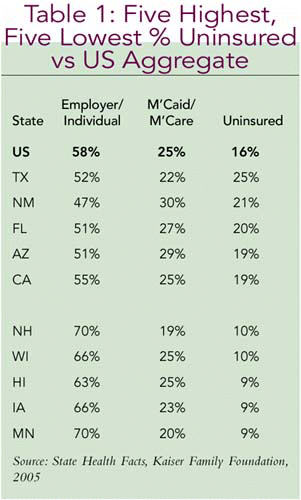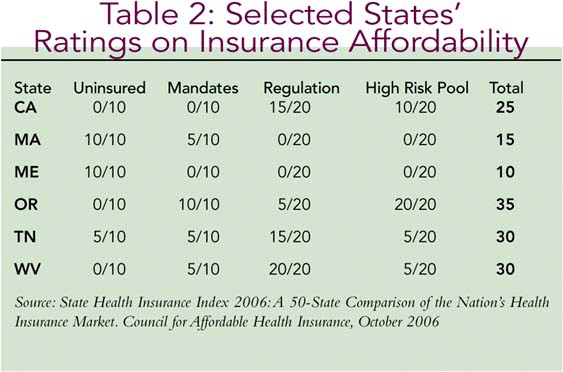With the federal government shouldering 45% of health care costs through five huge entitlements (see ENToday, April 2007) and a large federal deficit, the chance of politicians enacting a new federal entitlement for universal health insurance coverage is as likely as their conducting a smear-free political campaign. Absent a federal single payer system, states are going their own ways to expand coverage for their uninsured.
States are tailoring plans for universal coverage to their mix of demographics, politics, and health system components. They aim toward universal access and coverage, public subsidies for the working poor, with insurance including all state-mandated benefits. Common elements of state plans are freezing hospital and physician pay, offering plans with all state-mandated benefits covered, guaranteed issue, reliance on information technology for reporting, and forcing employers and/or individuals to either purchase insurance or pay penalties (see www.nahu.org/legislative/tools/state_mandates ).
To get a broad perspective on states’ attempts to cover their uninsured, looking at the percentage of uninsured reveals some significant demographic trends that may be overlooked when legislators design their programs to cover the uninsured (see Table 1). The states with the highest number of uninsured-Texas, New Mexico, Florida, Arizona, and California-all have large illegal immigrant populations. Additionally, their temperate climates and relatively attractive state tax rates entice large numbers of seniors. So the findings that the five states with the highest percentage of uninsured have only an average of 51.2% covered by employer/individual insurance, versus 67% for the states with the lowest percentage of uninsured, isn’t surprising. Illegal immigrants tend to not have employer-sponsored insurance. As for the 26.6% Medicaid/Medicare recipients in the five worst states, versus 22.4% for the five best states, that’s not surprising either. Logically, states with large numbers of illegal immigrants and seniors have more Medicaid and Medicare enrollees than states with larger percentages of employer-sponsored insurance.
Demographics tell a large part but not the entire story. The Council on Affordable Health Insurance (CAHI) index provides snapshots of each state’s health insurance environment. A high score indicates a competitive affordable market. By this measure, Alabama, Iowa, Idaho, Kansas, Kentucky, Minnesota, Mississippi, and Nebraska are best. States that CAHI says undermine consumer choice are Delaware, Massachusetts, Maine, New Jersey, New York, North Carolina, Tennessee, and Vermont. Perhaps that explains why Massachusetts, Maine, Tennessee and Vermont have been busy trying to fix their noncompetitive and expensive health insurance systems.
CAHI’s ratings (see Table 2) are based on the number of state mandates; state regulatory environments, particularly regarding guaranteed issue and community rating; and whether the state has well-functioning high-risk pools that act as a safety net for individuals with pre-existing medical conditions. The score listed in the table is the number of points out of the maximum-e.g., 15 out of 20 possible points in a given area.
While activity heats up in state legislatures, ENToday focuses here on four states currently gaining much attention for their plans to cover the uninsured.
Massachusetts
In 2005, Massachusetts’ Democrat-controlled legislature and Republican Governor Mitt Romney devised a radical plan to be implemented in July 2007 ensuring that all state residents have health insurance. The plan would try to enroll the state’s 100,000 Medicaid-eligible citizens, subsidize anyone below the federal poverty level (FPL) of $9800, and penalize individuals and small businesses failing to purchase coverage through a state-sanctioned insurance pool.
Of interest to other state lawmakers is the pay or play feature: employers with 100 or fewer employees will pay a 5% payroll tax and those with 100 or more employees a 7% payroll tax if they do not make insurance available to their employees. Starting in tax year 2007, Massachusetts residents who cannot prove they have health insurance will be penalized on their tax returns. The plan’s cost is estimated at $1.6 billion, most of it already available from existing state and federal funds.
The small business lobby went along with the plan because of the Connector, a new state agency linking employers and individuals with insurers that offer affordable products that include all of Massachusetts’ 40 mandated benefits (including in vitro fertilization, mental health, and bone marrow transplants).
Then there was a hitch. Initial bids for monthly premiums submitted by major insurers to the Connector were $380 per month, versus the $200 suggested in the original legislation. The Connector rejected $380 as unaffordable, and recently 10 major insurers agreed to offer plans for $175 per month ($109 if purchased with pretax dollars). Insurers are allowed to set copays, deductibles, and other out-of-pocket expenses.
Massachusetts’ plan for universal coverage piqued the interest of other governors, especially Arnold Schwarzenegger of California. Vermont’s plan is similar in that employers that currently do not provide coverage will either have to purchase it or pay fees. Jerry Geisel, a senior writer at Business Insurance, calls Massachusetts’ plan a logical approach. If the state has to subsidize people to get them to take care of health problems sooner rather than later, that avoids costly ER and hospitalizations down the road. The plan’s central concept, to provide appropriate solutions for different classes of uninsured people-enroll the Medicaid-eligible individuals in that program, subsidize the working poor into attractive competitive insurance plans, and require everyone else to buy insurance or pay a tax penalty-makes theoretical sense. But memories of Michael Dukakis’ Massachusetts Miracle of 1988, an employer-driven mandate for health insurance, which failed, come to mind. And it’s unclear how major insurers, including Blue Cross/Blue Shield of Massachusetts, Fallon Community Health Plan, Tufts Health Plan, and Harvard Pilgrim, could quickly drop their premium bids from $380 to $175.
California
Drawing on Massachusetts’ template to cover the uninsured, California’s proposal requires employers with 10 workers or more to buy insurance for their employees or pay a 4% payroll tax, physicians to pay 2% of their gross revenues, and levies a 4% tax on hospitals. Insurers would be prohibited from excluding applicants with pre-existing conditions and from spending more than 15% on administrative costs. Gov. Schwarzenegger plans to subsidize coverage of the nearly one in five uninsured Californians with the tax revenues mentioned above. He also plans to expand the SCHIP program by subsidizing families of four earning up to $60,000.
Roger Crumley, MD, MBA, Professor of Otolaryngology/Head and Neck Surgery at the University of California-Irvine, has struggled with the state’s low Medicaid reimbursement (60% of Medicare), and wonders how many more low-fee patients he and others can take on. Many doctors here don’t take Medi-Cal or Medicare because each case loses money. While a 2 percent tax on physician gross incomes sounds terrible it might not be so bad because those who have opted out low payers would then have to cover those of us who do treat these patients.
Another issue is California’s high managed care penetration rates, which have added to physicians’ low reimbursement rates, even for complex procedures. Dr. Crumley explains: Orange County has capitated Medicaid. Let’s say it’s 35 cents PMPM for 20,000 lives-$7000 a month for otolaryngology. One radical neck surgery sinks you. As for the governor’s funding mechanism, taxes on physician and hospital revenues, Dr. Crumley calls it an opening gambit for the negotiation to ensure that he gets something passed. There’s also talk about sweetening Medi-Cal reimbursement, which would help providers.
Maine
By creating Dirigo Health Agency, a state regulatory agency responsible for health care, Maine acted in 2003 to become the first state to legislate for universal access. Maine anticipated covering all 131,000 of its uninsured by 2009 through three core initiatives: Medicaid expansion, a state-designed and subsidized health insurance plan for individuals and employers, and regulation/cost controls.
Dirigo’s coverage is available to uninsured individuals, businesses, and municipalities with 50 or fewer employees, and to the self-employed. It provides discounts on monthly premiums, deductibles, and out-of-pocket expenses on a sliding scale. Private health insurers offering coverage through Dirigo must include Maine’s 45 mandated benefits.
One of Maine’s most significant contributions to the national debate on how best to cover the uninsured is its insistence on costs controls as the way to liberate money to subsidize care. Reducing its $275 million bad debt and charity care, a one-year moratorium on capital expenditures, tighter rules for certificates of need, and strengthened oversight of insurance rates are among Dirigo’s cost controls. One of the more controversial was the voluntary cap on provider costs and operating margins. Dirigo requested hospitals to limit their cost growth to 3% per year and their operating margins to 3.5%, and insurers to cap operating margins at 3.5%.
Determining the amount of cost savings has been a contentious issue. In 2005 the state claimed to have saved $110 million, but only $48.7 million could be certified. The amount of savings mattered because health plans and employers had to match it. They filed suit, arguing that the savings was a tax and the savings offset payment an unconstitutional delegation of the legislature’s taxing powers. In 2006 Maine’s superior court ruled in Dirigo’s favor, saying that the offset payments are the means by which the legislature redistributed savings in the healthcare system to make health insurance available to a greater percentage of Maine citizens.
Apparently, Mainers are indifferent to the state’s largesse. In 2005 Dirigo expected to enroll 27,000 people; only 9,000 signed up. Of those, only 2,000 were uninsured.
West Virginia
In West Virginia, Medicaid’s $2.1 billion budget is the state’s largest single line item, and there are 245,000 uninsured citizens. In 2004 the state created a partnership with insurers to offer a small business plan at 25% below market rates. Steve Wetmore, MD, Chairman of the Department of Otolaryngology at University of West Virginia School of Medicine, says that SCHIP and Medicaid don’t pay much but are fairly open. We and the patients don’t have to jump through many hoops for service, which is good.
What makes West Virginia’s initiatives intriguing is that it has gone beyond fiscal mechanism to focus on patient and physician behavior. Medicaid patients must agree to health screenings, avoid unnecessary emergency room visits, keep doctors’ appointments, and follow physician orders. Physicians are legally obligated to report this information to the state Medicaid agency. Furthering personal responsibility, the state has targeted 75,000 obese citizens that it estimates contribute $100 million annually to the Medicaid health care tab. Modeled after Tennessee’s successful program, they are entitled to free Weight Watchers services.
West Virginia has also embraced the advanced medical home (AMH), a concept promoted by the American College of Physicians. William Golden, MD, Chairman of the ACP’s Board of Regents, says, Congress was very receptive. An AMH is usually a primary care practice that is paid for coordinating care with specialists and other resources, although a specialist may be the AMH.
Overall, Dr. Wetmore sees West Virginia’s initiatives as forward and backward steps. The state legislature is losing out on a 3:1 federal match for Medicaid dollars. We can’t afford to leave money on the table…. Our leaders are also looking at worker’s comp and underfunded teachers’ pensions, pulling them in too many directions. Although he likes the state’s initiatives to help Medicaid and the uninsured, he doubts it will help surgical specialists because it’s geared to primary care.
One way or the other, most states are searching for strategies to expand health care coverage. Employer mandates, aggregate purchasing power, new taxes, limiting benefits, expanding Medicaid, consumer-directed care, and cost controls are the tools they’re using. Unfortunately, states seem to see providers as part of the problem rather than part of the solution. As states play Robin Hood, taxing physician and hospital revenues to provide coverage for the poor, it is hard to see how specialists will derive benefit from treating patients with subpar insurance-unless Dr. Crumley is right, and the physicians who eschew Medicaid and other lowly payers start to pay their share.
©2007 The Triological Society




Leave a Reply